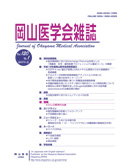

Journal of Okayama Medical Association
Published by Okayama Medical Association<Availability>
Full-text articles are available 3 years after publication.
Permalink : https://ousar.lib.okayama-u.ac.jp/19537
Studies on the Effect of Adrenalin, Cortisone and ACTH on the White Blood Cell especially on the Eosinophilic Leukocyte by the Tissue Culture of the Bone Marrow - mainly on the mechanism of eosinopenia - Part (Ⅱ) Influences on the same drugs (adrenalin, cortisone and ACTH) on the peripheral and bone marrow eosinophilic leucocyte of hypophysectomized dogs (mainly by bone marrow culture)
Yamamoto, Shinro
Published Date
1956-07-31
Abstract
I have studied adrenalin, cortisone and ACTH eosinopenia in hypophysectomized dogs by means of chamber counting. In addition, the bone marrow of hypophysectomized dogs was cultivated in using the plasma of normal and hypophysectomized dogs separately, cortisone was added to each preparate. The results obtained are as follows: (1) Adrenalin eosinopeia is due to its direct influence upon the eosinophil partly through the pituitary body. (2) ACTH acts as glucocorticoid in ACTH cosinopenia. This brings about the similar result to cortisone eosinopenia. But ACTH eosinopenia has no correlation with the function of the pituitary anterior lobe, while cortisone eosinopenia requires the normal function of the anterior lobe. (3) Cortisone (compound E) alone can not cause cortisone eosinopenia but it gives hypofunctional influence and developmental disturbance upon the eosinophil in synergism of other compounds. (4) The normal functions of both the adrenal cortex and pituitary anterior lobe is necessary for eosinopenia by cortisone administration. (5) Cortisone test can be used as a test of pituitary anterior lobe function only in the case with normal adrenocortical function.
ISSN
0030-1558
NCID
AN00032489
